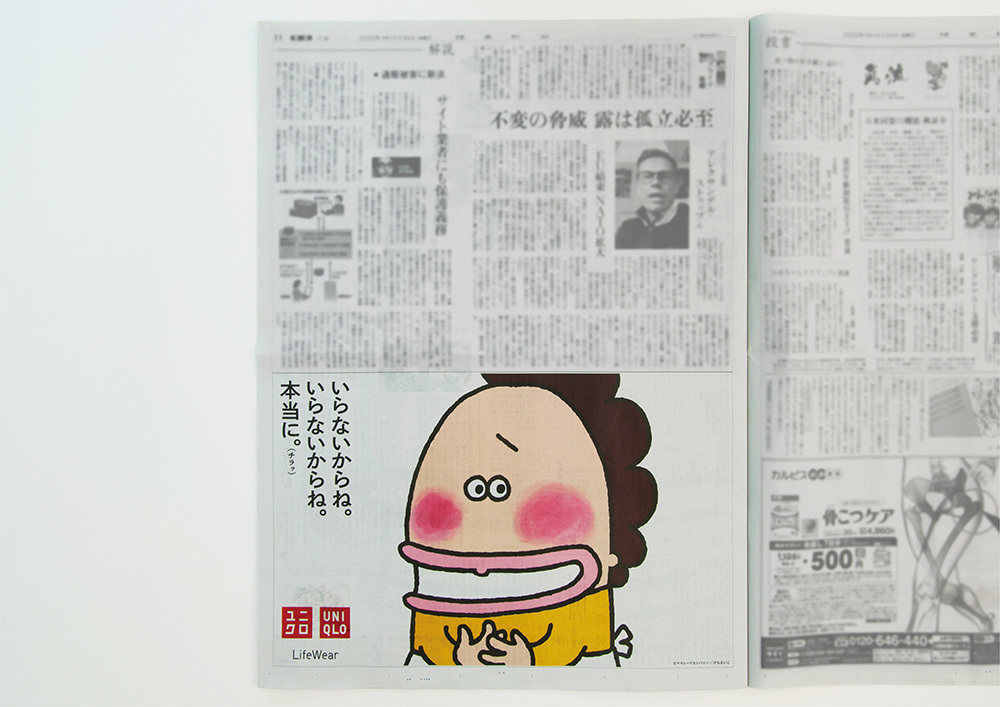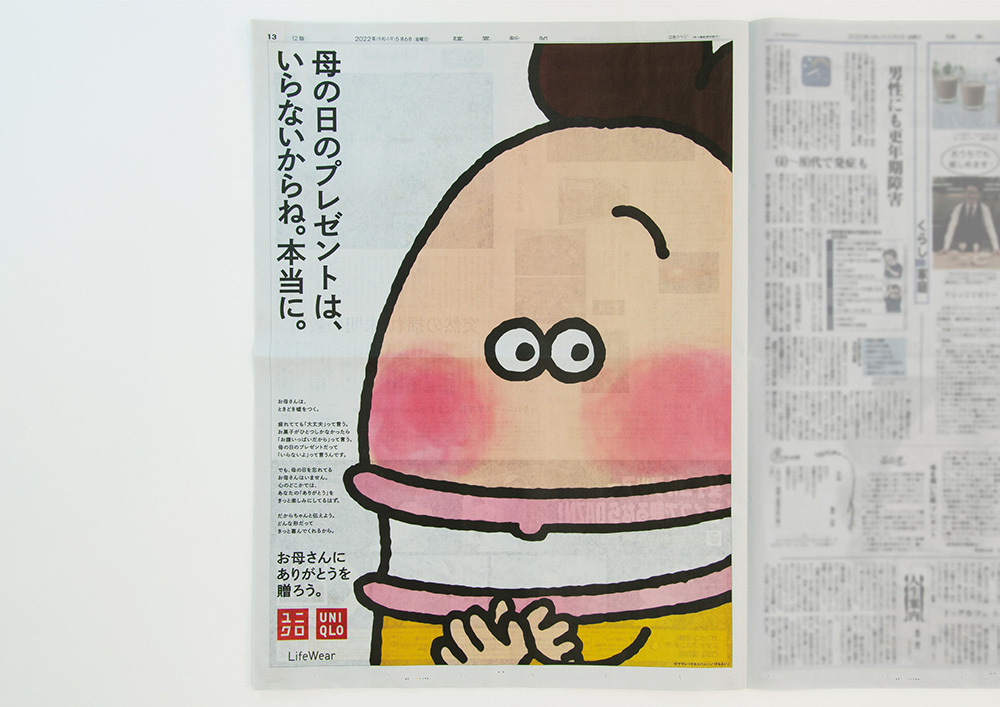Dentsu Inc.'s cross-functional creative organization, the Future Creative Center (FCC), is a group of over 70 members supporting future-building initiatives with creativity beyond the realm of advertising. In this series, FCC members discuss their upcoming projects under the theme "Future × Creativity."
UNIQLO's newspaper ad for Mother's Day 2022, published in the Yomiuri Shimbun, drew significant attention. It captured the heartfelt sentiment that while mothers secretly look forward to gifts, they tell their children, "I don't need anything."
Unusually for a newspaper ad, it took the form of a "four-page spread," featuring a mother unable to fully hide her true feelings, which became a talking point. Furthermore, this ad was part of a set with a Father's Day counterpart; about a month later, a newspaper ad for Father's Day appeared, serving as a kind of "answer."
Behind these campaigns were Dentsu Inc. FCC's Makiko Ido (Creative Director/Planning Director) and Taichi Tamaki (Art Director). What journey led to this idea? Based on their accounts, we look back at the creative process.
――What sparked this advertising project?
Ido: It began when UNIQLO approached us for communication support ahead of Mother's Day and Father's Day. The core challenge they shared was that "UNIQLO is rarely chosen as a gift option for Mother's Day or Father's Day." They wanted to run a high-ROI promotion within a limited budget that would position UNIQLO as a viable gift choice.
Since Mother's Day comes first, we decided to research Mother's Day gifts themselves. We conducted social media analysis and in-depth interviews.
Our research revealed many people struggle with Mother's Day gifts. Comments included: "I want to give something special, like a proper present with a sense of occasion, but I can't think of anything good," and "I'd like to do something every year, but when money is tight, there are years I don't do anything."
This made us wonder: "Has Mother's Day become too much of a special event?" Perhaps it's become so special that it actually makes expressing gratitude harder.
We also discovered that UNIQLO seemed like a slightly underwhelming choice for a day when people feel they must give an extraordinary gift.
Tamaki: And that's why people don't easily associate UNIQLO with Mother's Day gifts. So instead of making an ad tied to UNIQLO products, we decided to take a step back and create an ad that reimagines Mother's Day as a more casual "day to easily express gratitude." The same approach applies to the subsequent Father's Day ad.
Ido: Achieving that would solve the emotional challenges people face around Mother's Day and Father's Day, while also solving UNIQLO's business challenges. We set this as the goal for this ad campaign.
The Ingenuity Behind the "Truly Cuddly Experience" Embodied in Mom's Design
――In the actual newspaper ad, the character Mom from "Atashi's House" is depicted saying, "I don't need any presents," while snuggling up. How did this idea come about?
Ido: During team brainstorming, everyone said, "Moms always say 'I don't need a present,' right?" But I'm a mother of three myself, and I chimed in, "No, no—they say that, but they actually look forward to it because they're happy to receive thanks from their kids!" (laughs).
Tamaki: As we explored more ideas, one copywriter brought a concept with a slight variation in the phrasing of the mother's "I don't need it." Since it was a remote meeting, the same line appeared repeated two or three times on the slides, and it looked visually interesting. That sparked the idea: have her repeatedly refuse with the same words while actually wanting the gift and coming closer.
Ido: It wasn't that we settled on one specific idea; rather, the entire team's ideas gradually rolled together until we arrived at this.
――Were there any particular points you focused on during production?
Tamaki: Design-wise, the fun part is that the mother gradually gets closer with each page turn, so we really wanted to give the reader that experience of her approaching them. Therefore, we didn't just gradually enlarge the ad space itself; we also made the mother herself progressively larger within the frame.
Additionally, we used a camera angle so the newspaper reader and the character make eye contact. Also, if you look at the four illustrations, you'll notice subtle changes in her expression—like the redness of her cheeks or her eyebrows. We thought these details would add realism and strengthen the "approaching experience." We conveyed these requests to the original author, Eiko Kera, and she created all the illustrations specifically for this project.
Ido: Another key element we focused on for this ad was the body copy on page 4.
Since our ultimate goal was to make Mother's Day more casual and encourage people to freely express their gratitude, we infused that sentiment into the body copy. We were thrilled by the strong social media response to this copy as well.
Also, even if we had used the same words in a single-page ad, it might not have resonated as deeply. Because the words came after showing the process of the mother coming closer, I think they connected more effectively.
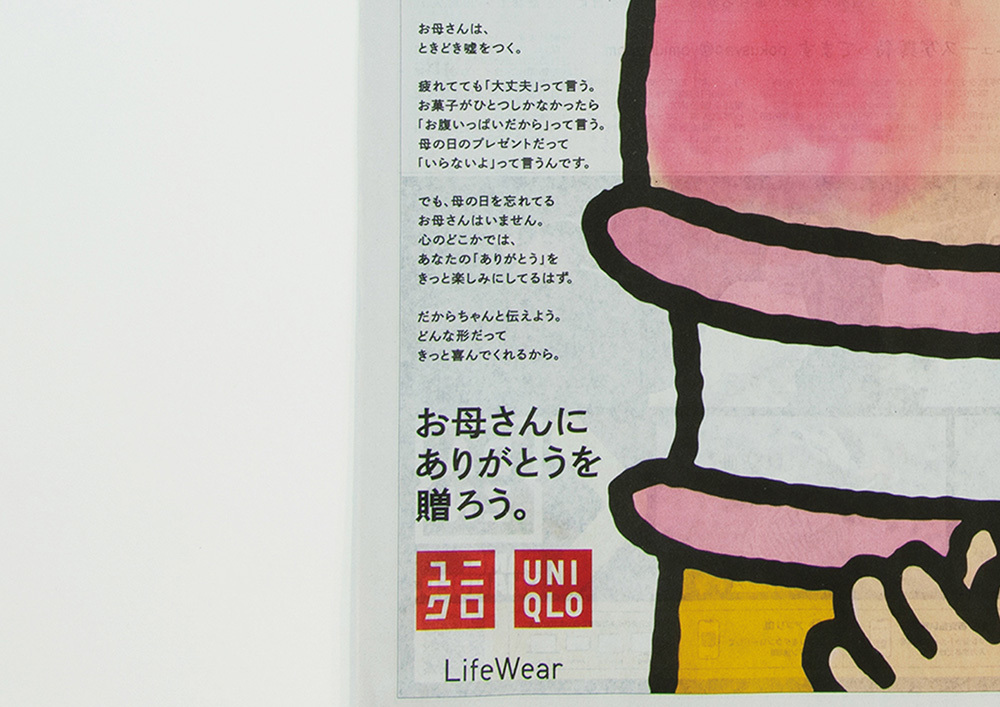
――Regarding the response after release, is there anything that stood out to you?
Ido: On Twitter, we reached a total of 27.6 million impressions. The most shared tweet received 240,000 likes. Many people also wanted this newspaper, and it sold out after being listed multiple times on Mercari. The unexpected response surprised us.
Father's Day, which can often feel overlooked. The sentiment behind the countless dots in the Father's Day ad
――And then, on June 15th, the Yomiuri Shimbun featured UNIQLO's newspaper ad aimed at Father's Day, just four days away. Could you tell us about that as well?
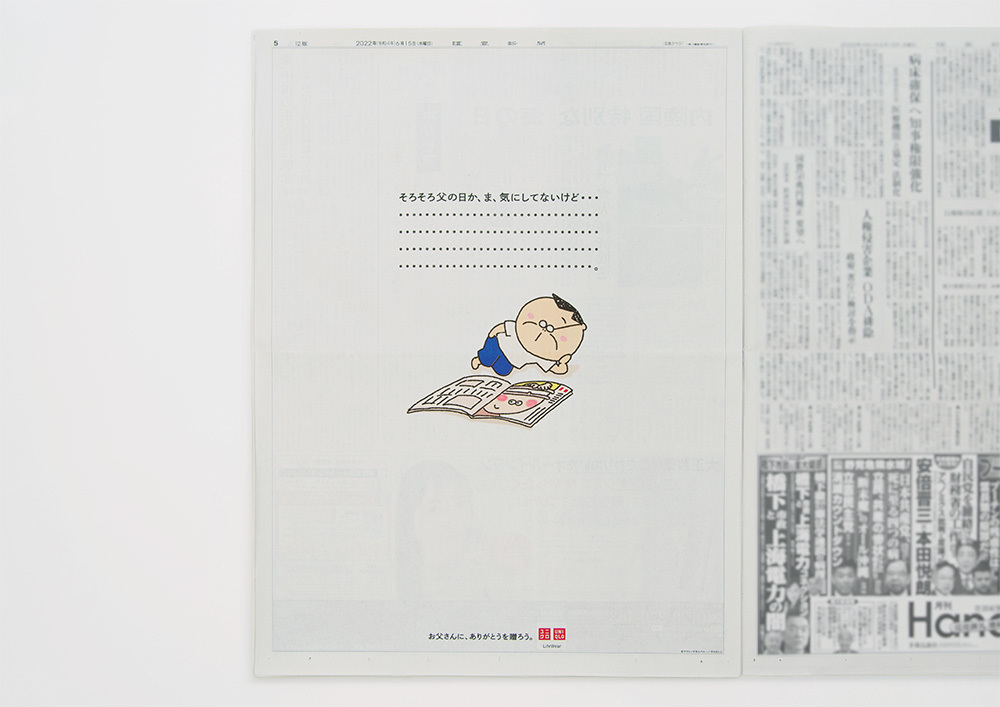
Ido: Since our Mother's Day ad themed around mothers' true feelings resonated, we decided to make "fathers' true feelings" the theme for Father's Day. But honestly, fathers' true feelings are even harder to grasp than mothers'.
So this time, we conducted in-depth interviews with the fathers themselves, the recipients. What emerged was: "Mother's Day comes first, so I can't help but compare. There's this lingering worry that it won't be as big a deal as Mother's Day, and I try not to think about it."
Tamaki: Mother's Day comes first, and the excitement naturally leans that way. Fathers seem like they don't care, but they do. We wondered if we could turn that dynamic into entertainment. So we created a scene where a father, lying down, looks at the Mother's Day newspaper ad we mentioned earlier, pretending not to care.
The countless dots following "I don't care" express Dad putting on a brave front. But if you look closely, there are letters written inside the dots, and connecting them spells out this sentence:
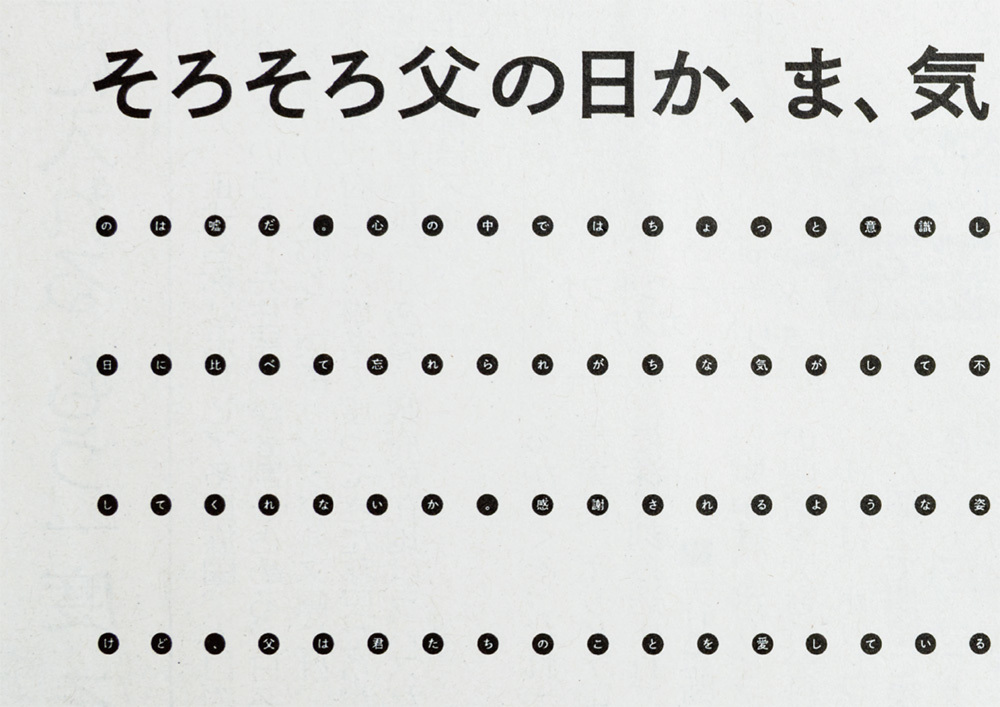
That's a lie. Deep down, I'm a little conscious of it.
I feel uneasy that Father's Day tends to get forgotten compared to Mother's Day.
Children, please understand.
I'm not confident I've shown you anything worthy of thanks,
but your father loves you. This is my heartfelt truth.Ido: The sentiment that "he seems not to care, but he does" isn't limited to Father's Day. It connects to a father's feelings for his children. We also infused this copy with the love for children we sensed from fathers during the depth interviews.
Tamaki: What we focused on during production was how the letters inside the dots appear. At first glance, they look like ordinary dots, but if you look closely, you notice the letters. We searched for that perfect balance.
Ido: Regarding the size of the letters inside the dots, Tamaki tested an astonishing number of variations.
Tamaki: Initially, people reacted with "UNIQLO's Father's Day ad is here, following Mother's Day!" Then, after a while, some noticed "There's text written inside the dots." Our copywriter called it a "two-stage rocket approach." It was great to build that momentum successfully.
Reflecting on Future Advertising Communication Through This Project
――Through this project, what did you feel was important in approaching advertising?
Tamaki: What I felt was the importance of raising your perspective. Advertising has always created new cultures and values, but lately, with the world moving so fast, ads often end up chasing trends that started on social media. As someone in an ad agency, that feels a bit sad, and I know it's tough, but I still want to create ads that really get people excited.
To achieve that, I believe elevating your perspective is crucial. This ad, for instance, wasn't just about promoting a product; it took a higher perspective by supporting mothers. I think if we can do more things like this, we'll create more content that people find genuinely interesting.
To elevate that perspective, I feel it's crucial to repeatedly ask "Why must we do this?" Even when creating ads to sell a product, we must dig deep: Why must this product be sold? Why must this product exist in the world? Sometimes, this leads all the way to the company's raison d'être – why the company itself should exist. But ads that touch on that level tend to be clear to viewers and don't feel like they're being lectured to.
Ido: Since I started in the marketing division, I've had extensive experience finding target audience insights.
Lately, I'm often asked how to find insights. The methods haven't changed since my days at the Data Marketing Division – catching a word someone casually slips out during depth interviews or brainstorming sessions. However, I feel its value is resurfacing precisely now, as data analysis becomes widespread. While data reveals more, it also highlights what data alone cannot uncover.
Moving forward, I want to challenge myself in various fields by combining the "ability to uncover unspoken 'desired futures for people and society'" I've cultivated over the years with the evolving "power of Dentsu Inc.'s creativity."





